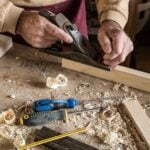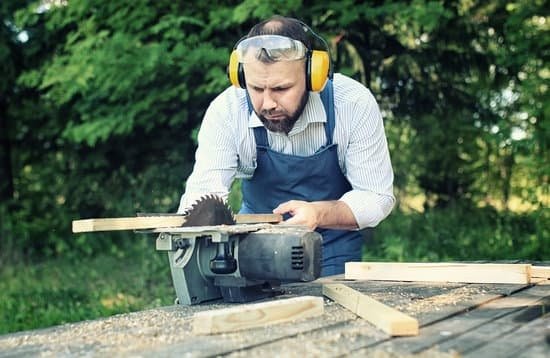Introduction
Woodworking machines are powerful tools that make it easier to manipulate wood into a desired shape or structure. They can cut, drill, grind and shape wood into any size or design you need. Woodworking machines come in many varieties and sizes, such as lathes, saws, routers, planers and shapers among others. Each type of machine has a different purpose and use but all are designed to help increase productivity in the woodworking process.
These machines make it possible for individuals or companies to create customized pieces of furniture or other wooden objects with accuracy and consistency. The ability to accurately measure and shape wood helps ensure correct sizing when constructing projects like cabinets and tables. Woodworking machines also enable creative designs such as intricate scrollwork on decorative furniture or carvings. Many machines can be used for multiple purposes depending on the attachment used which adds versatility within one shop setting.
Safety is an important factor when using any machinery; properly using protective gear while operating these powerful tools will help minimize risks of injury associated with improper use of tools. Woodworking machines require adequate space in the shop environment which allows users to freely maneuver around them without risk of damage to the machine itself or its user’s safety. Regular maintenance on these tools is essential to keep them functioning properly which will extend the life expectancy for a tool’s life span drastically. Additionally, some woodworking machines may have pricing restrictions due to their advanced technology so researching each tool before making any purchase decisions is beneficial to everyone from beginner level users all the way up to experienced professionals.
Machines for woodwork provide numerous advantages over manual methods due to their efficiency in productivity, accuracy, creativity and even safety when handled correctly; this makes them ideal in various settings ranging from businesses dedicated exclusively to producing wooden items all the way up large-scale industrial settings where precision is essential unless major financial repercussions could occur because of mistakes made during production cycles. A wide range of woodworking machinery offers many options for what an individual might need in a particular situation so having a good understanding of each type available as well as considerations like cost and available space are hugely beneficial before selecting what equipment may work best for specific needs .
Types of Woodwork Machines and Their Capabilities
Woodworking machines are essential for a wide variety of woodworking tasks from woodcutting to crafting. Depending on the complexity and scope of your project, different types of woodwork machines can be used to help you quickly make precise cuts and create intricate designs. Popular choices include saws, routers, sanders, joiners, planers, lathes and drill presses.
Saws are ideal for straight cuts and can range from a basic hand saw to an industrial table saw that can slice through even the toughest materials with ease. If you’re looking for more precise results, then a router is your best bet. This tool creates intricate designs by routing away excess material. Sanders allow you to quickly smooth out large surfaces without having to sand them by hand. Joiners are also very useful because they are able to accurately glue pieces together or alter pre-existing joints completely. Planers come in handy when working with long thin projects such as decking boards or other similar items as they cut down each piece evenly so that they match one another perfectly. Lathes are perfect for those who want to craft unique shapes and turnings while drill presses will give you the ability to make holes at specific depths accurately and cleanly every time.
Overview of the Most Popular Woodworking Machines
Table Saw: Table saws are one of the most popular power tools used in woodworking. They are versatile and can be used for multiple types of cuts, from rip cuts to cross cuts. Table saws are perfect for larger projects, such as cutting sheet materials or ripping boards. Many table saws come with an adjustable fence so you can make more precise cuts and miters.
Drill Press: A drill press is a specialized tool for drilling accurate holes into materials like wood, plastics, and metals. It’s incredibly precise and is great for home DIY projects as well as professional settings such as shops and workshops. Drill presses can come in different types including standing, benchtop or even handheld models. You can also choose whether you want a corded or cordless model depending on your preferences.
Router: A router is another power tool typically used in woodworking projects. Routers enable you to add intricate details to your projects like moldings, curves, shapes and other decorative elements. They arrive with various attachments designed to perform specific tasks such as trimming edge bearing bits or slot mortising bits which help create joints between pieces of wood.
Jointer: A jointer is one of the most important machines when it comes to preparing lumber for a project before it goes onto the table saw or router table. With this machine you can level the edges and faces of lumber pieces allowing them to be milled accurately without interruption from any rough projections or burrs that may have formed during the milling process. Jointer machines also provide slots which allow you to cut biscuit jointed slots into workpieces in order to achieve strong butt joints without having to use clamps or screws during assembly process on large projects like house frames or furniture frames.
Factors to Consider When Choosing a Woodworking Machine
When it comes to woodworking, having the right machine is key to success. Choosing the right machine can be a daunting task due to the many options available. Here are some factors to consider when selecting a woodworking machine:
1. Type of Woodworking Project: The type of project your planning will determine what type of machine you need. If you’re making cabinetry and furniture then you’ll need machines such as saws, routers, sanders, planers, jointers and a lathe. If you’re only doing basic wood repairs or building small items such as birdhouses or closet organizers then simple tools may suffice.
2. Machine Features: Consider the features that come with particular machines. Some machines offer variable speed controls or advanced dust collection systems among other features that may be beneficial for your projects. Check out reviews online and user experiences with particular tools before investing in something more expensive and complex than necessary for your specific needs.
3. budget: Determine how much money you can realistically invest in a new machine prior to browsing through various models available on the market today. Being aware of your budget will help keep you from getting attached to an item that’s simply too expensive for your pocketbook at this time. Planning ahead also allows you to save up and purchase something that fits within your long-term needs versus settling for a cheap model that won’t get the job done correctly or efficiently.
Common Myths About Woodwork Machines
One of the most common myths about woodwork machines is that they are difficult to use. While some machines may be intricate, especially complex ones, many woodworking machines are no more complicated than other tools. With clear instructions and a little practice, anyone can become familiar with the basic operations needed for completing projects.
Another myth about woodwork machines is that they require a lot of money for purchase and upkeep. Many types of effective and efficient machines are available at reasonable prices, even when looking for pre-owned models. Additionally, proper care is key to any machine’s longevity; by taking simple precautions such as keeping the blades sharpened and using appropriate lubrication, any machine will be able to give consistent performance over time.
A third myth surrounding these types of machines is that people need special training in order to use them safely and accurately. While some people may benefit from additional instruction in certain techniques or operations, woodworking machines are actually quite straightforward if used correctly. Moderately experienced users can easily pick up the basics with just a few simple tips or step-by-step tutorials followed by plenty of practice.
Safety Tips When Working with Woodworking Machines
When working with woodworking machines, it’s essential to take safety precautions to protect yourself and those around you. In order to avoid dangerous situations and possible injury, here are some things to keep in mind:
1. Wear the proper personal protective gear – This is the most important tip and should always be followed when using any kind of machinery. Appropriate items of clothing include goggles, gloves, sturdy boots, and a dust mask to protect against dust particles generated by sanding or sawing.
2. Read your manual – Many accidents are caused due to improper use of machines. To use a machine correctly and safely, read the instruction manual so you understand how it works and what actions need to be taken each step of the way.
3. Secure materials securely – Before turning on any machine, ensure all components are firmly secured in place in order to prevent slipping during cutting or routing operations. Additionally, it’s important to make sure there’s enough space for saws or clamps so your materials dont get trapped between them as this could lead them becoming lodged during operation or cause cuts or other injuries when releasing them from the machine.
4. Keep guards in place – Woodworking machines tend to come equipped with guards that cover moving parts such as blades or router bits; never remove these guards from your machine as they’re there for your safety! Guards should also be checked regularly for any damage as well replacements should occur immediately if needed for maximum protection.
5. Unplug before making adjustments – Before changing bits on a router table, tightening fences on a table saw, adjusting blade angles on miter saws”basically anything that requires tinkering”always remember unplugging first! This will help ensure there aren’t any accidental switches while you’re repairing or changing out components which could result in an unexpected start up while yours hands are closeby leading potential injury risk
Developing the Skills Necessary to Use Woodwork Machines
Using machines for woodwork can be a very rewarding hobby or profession. As with any project involving complex tools, learning the skills necessary to operate the machines safely and effectively requires practice. Depending on the type of machine, skill sets may range from basic operations such as sawing, forming, and drilling; to more intricate skills like shaping, sanding and varnishing. To become proficient at these tasks, it is important to understand each machine’s individual capabilities and limitations.
In addition to developing specific power tool skills, other concerns include safety protocols and techniques that ensure adequate workspace preparation and clean-up. Safety gear such as gloves, goggles and dust masks should always be worn while operating power tools. Practicing proper posture when using the machines will help avoid injury in the workshop setting or job site. Furthermore, understanding how different types of materials affect cutting processes is an important part of success with woodworking machines.
Finally, learning how to properly maintain each machine is essential in obtaining quality results. This includes ensuring that each cutting blade or bit is sharpened appropriately, understanding when wear parts require replacement; lubricating under normal operating conditions; keeping dust removed from motors to prevent overheating; and checking the tension of belts to make sure cutting performance remains consistent over time. With consistent study and practice of these concepts, anyone can develop their skill sets for safe operation of woodworking machines successfully!
Closing Remarks
Owning woodwork machines can have many advantages. It gives the user the ability to make a wide variety of projects with precision, accuracy, and quick turnaround times. Woodworking machines also allow users to create intricate details and complex shapes that are difficult to achieve without high-end equipment. It is easier for novice builders to work with complex projects thanks to the automation when using machines as opposed to hand tools. This savings in time allows for an increased level of efficiency in project completion. Finally, owning machines ensures that you can continually use them for multiple projects over many years with little maintenance beyond its scheduled service intervals.

Hi everyone! I’m a woodworker and blogger, and this is my woodworking blog. In my blog, I share tips and tricks for woodworkers of all skill levels, as well as project ideas that you can try yourself.





